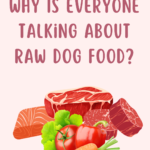The world of dog food can feel like a jungle, brimming with options. From neatly packaged kibble to gourmet cooked meals, pet owners have many choices. But lately, a new trend has emerged: the raw food diet.
Proponents hail raw dog food as a return to nature’s bounty. Many claim it can increase energy and shine your dog’s coat.
However, venturing into this untamed territory necessitates a cautious approach. While the allure of a natural diet is undeniable, potential health risks for both pets and humans, along with the challenges of creating a balanced raw food regimen, raise concerns about the true value of this wild path.
Before you switch your dog’s food to raw food, let’s explore the claims and challenges of feeding raw food to your dog.
The Allure of the Raw Dog Food Diet
The call for raw food is founded on the promise of a healthier, happier dog. Most raw food proponents paint a picture of a diet more aligned with a canine’s evolutionary past. They paint kibble as being ultra-processed and incredibly modern.
This connection to the ancestral roots and wild resonates with many pet parents and especially with me as my dog is 30% grey wolf!
Often, advocates tout a range of health benefits, such as improved digestion. Some also claim to see improvements in their dog’s coat health, such as less shedding.
However, all of these claims lack scientific backing. This isn’t due to a lack of scientific studies, either. Dozens have been performed, but almost no high-quality evidence for these benefits has occurred.
Of course, there is also the often-mentioned yet difficult-to-measure factor of pet satisfaction. Our dogs may be happier eating the variety and freshness of raw diets, but this is impossible to know for sure.
Dangers of Raw Food
While many people are allured by the promises of raw diets, venturing into this untamed territory comes with several risks. While commercial kibble is exceptionally safe for pets, raw meat differs greatly.
Bacterial Contamination
Raw meat contains many dangerous pathogens, including Salmonella, E. coli, and Listeria. These bacteria are dangerous to humans and dogs, and they aren’t uncommon. One study found that over 50% of commercially available raw dog food diets contained harmful bacteria.
Our dogs don’t “destroy” these bacteria upon consumption. Another study found that 30% of stool samples from raw-eating dogs contain Salmonella, which could affect other dogs and people.
Nutritional Imbalances
Creating a balanced raw food diet is much harder than you may think. Unlike commercial options formulated by veterinary nutritionists, raw food is often more of a shotgun approach to nutrition.
For instance, hyperparathyroidism and limb deformation have been reported in puppies consuming raw food. The diet contained too much phosphorus, leading to problems with bone formation.
Another dietary study looked at the nutrition of five different raw diets. All of the diets were too high or too low in a necessary nutrient (and most had several nutritional problems).
If you did decide to feed your dog a raw food diet, you would need to be extra careful that they are getting all the necessary vitamins and minerals and in the correct quantity.
Danger to Humans
An often-overlooked risk of feeding raw food is the danger to humans in the household. Often, young children who spend a lot of time on the floor (where the pet also spends time) are at the greatest risk.
One study examined an outbreak of Salmonella at four animal facilities. Eighteen humans and 36 animals were infected, though not all were symptomatic. Some of the animals even died. Several children were among the infected people.
Because a dog’s feces become contaminated when they consume raw food, soil in the area can also be affected. Children can pick up the bacteria just by playing outside or on the floor near where the dog eats.
Moving Forward with Caution
The raw food trend has become exceptionally popular over the last few years. While visions of healthier, happier dogs can be alluring, there isn’t much evidence to support them. As with any jungle, safely navigating a raw food diet can be difficult.
It’s important to weigh the potential benefits against the inherent risks. While the claims of improved health are enticing, you must consider the risk of bacterial exposure to yourself, your dog, and your family.
Creating a balanced, raw diet is also exceptionally difficult. Most raw diets are not nutritionally complete and can have profound health implications.
You could consider doing something similar to what I do with my dog and mix commercial kibble that is high in protein with raw food aspects such as eggs and fish oil. Not only is this great if you are working on a budget but you also don’t need to worry about your dog’s nutritional needs being fulfilled.
As always, consult your veterinarian and do plenty of research before adjusting your dog’s diet.



